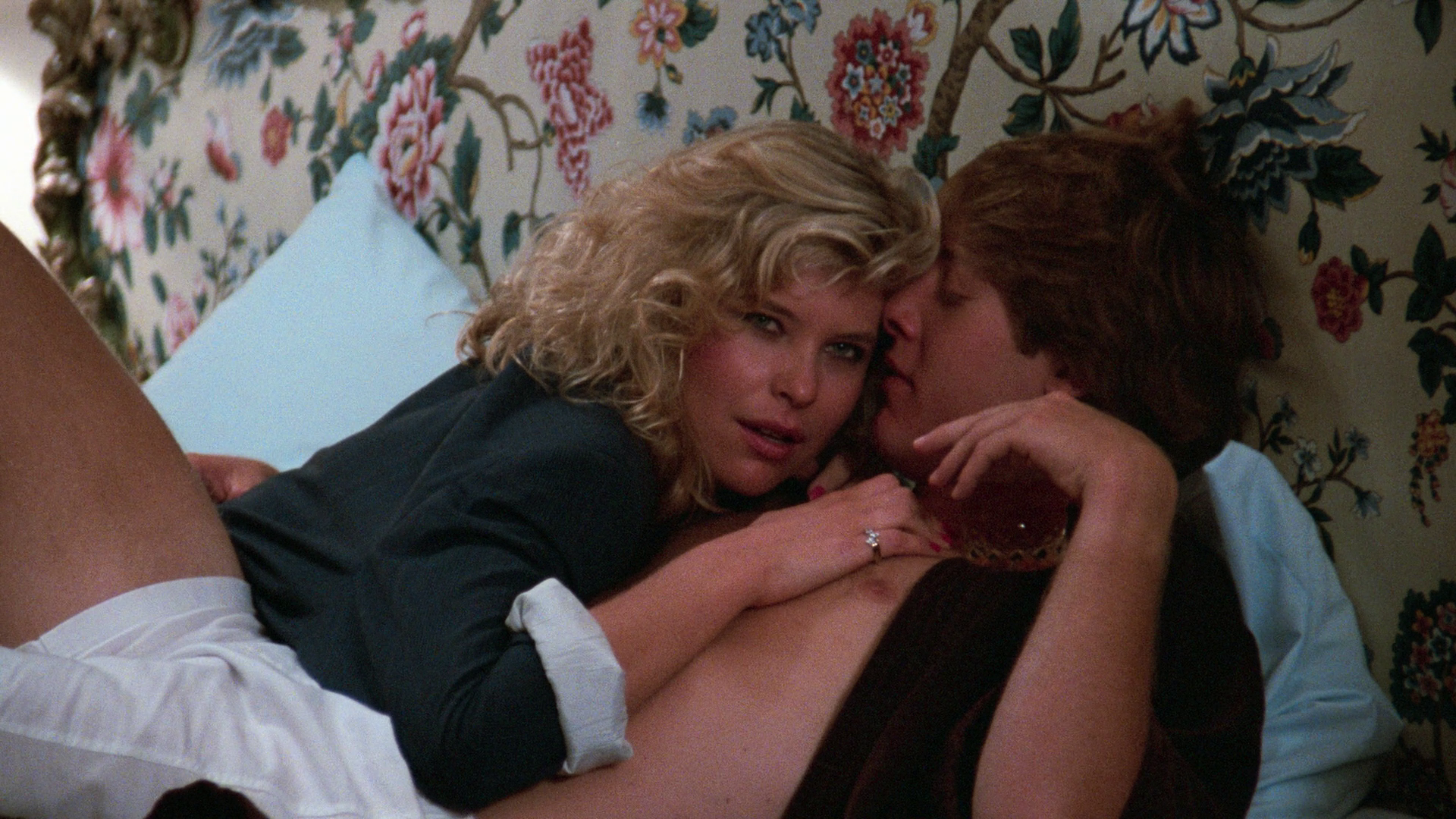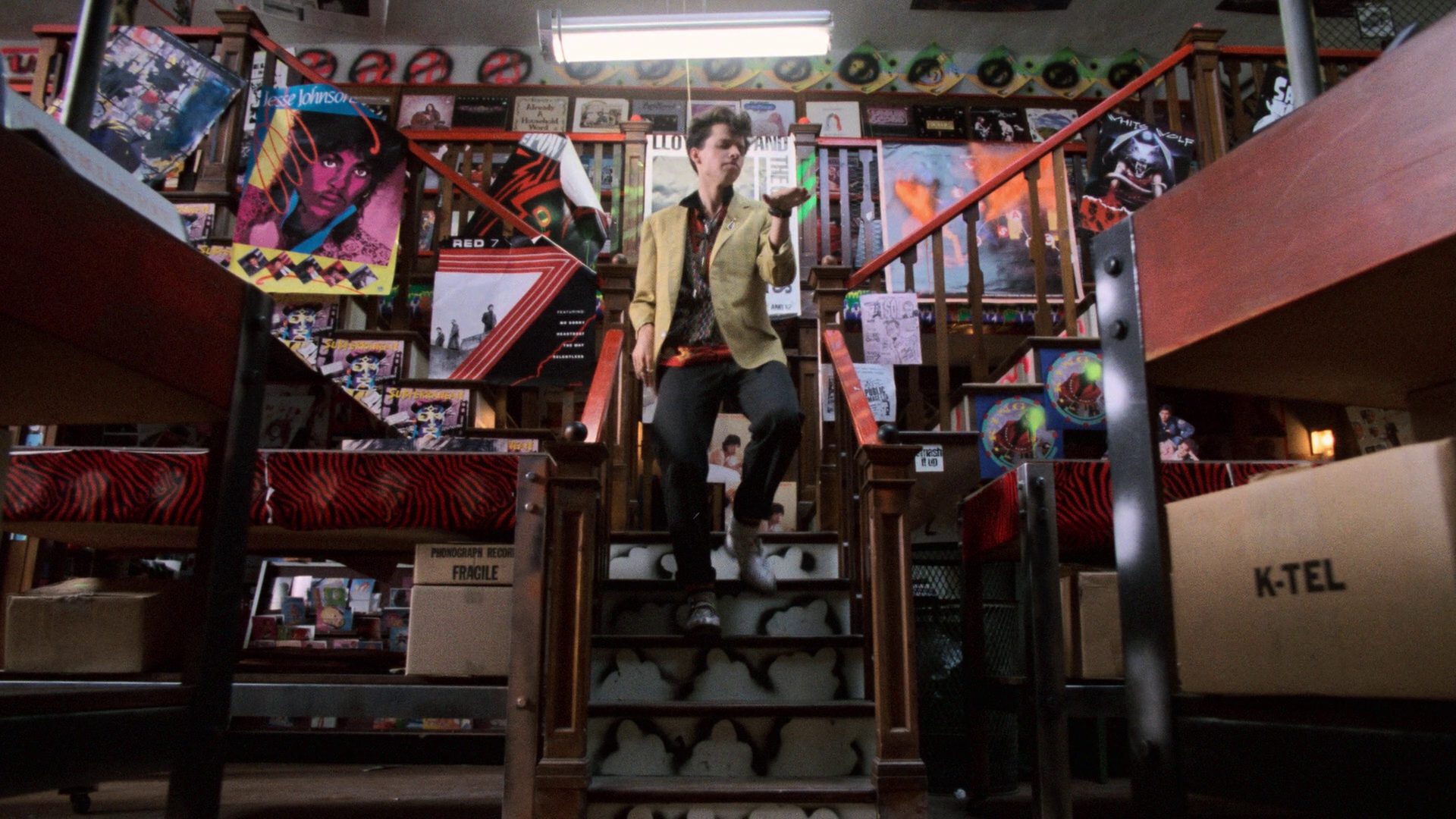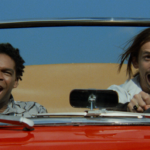**/**** Image A Sound A+ Extras B-
starring Molly Ringwald, Harry Dean Stanton, Jon Cryer, Andrew McCarthy
written by John Hughes
directed by Howard Deutch
by Bill Chambers John Hughes made his mark with screenplays that had straightforward, saleable hooks. National Lampoon’s Vacation is about a suburban family on a cross-country drive to a theme park. Mr. Mom is about a husband and wife switching places as the breadwinner of the family. Sixteen Candles is about a girl turning 16 whose family forgets her birthday. The Breakfast Club is about five high-school students serving detention on a Saturday. Weird Science is about a couple of geeks who Frankenstein themselves the perfect woman. But Pretty in Pink, inspired by though not based on The Psychedelic Furs‘ song of the same name, is an outlier in Hughes’s early filmography in that it’s merely an ode to his muse Molly Ringwald, its collection of feeble pretexts for shining the spotlight on her hardly constituting a premise. It’s a movie that operates on the somewhat shaky assumption that Ringwald, like Anna Karina before her, is cinema, her most mundane gestures becoming iconic through the simple act of photographing them. The ultimate irony, of course, is that when Hughes transposed every non-event that happens in Pretty in Pink onto Some Kind of Wonderful a year later, it resulted in what was arguably his most high-concept project yet: the boy version of Pretty in Pink.
Pretty in Pink does have a plot, and it goes something like this: high-schooler Andie (Ringwald) is best friends with Duckie (Jon Cryer), who is privately but transparently in love with her. They are both poor. One day she catches the eye of Blane (Andrew McCarthy). He is rich. Blane asks her out on a date while Duckie is still working up the courage to express his true feelings, and she says “yes.” Duckie is butthurt. A relationship blossoms, but the class divide between Andie and Blane seems to widen rather than close. Blane asks Andie to the prom, only to renege. Andie and Duckie go stag to the prom, reconcile, and are surprised to discover that Blane is likewise there by himself. Blane tells Andie he loves her. With Duckie’s blessing, Andie ditches him for Blane. Blane and Andie kiss in the moonlit parking lot. Duckie receives a consolation prize in the form of Kristy Swanson, billed as Duckette. The end. Once upon a time, Pretty in Pink concluded very differently, with Andie discovering some latent romantic feelings for Duckie on the dance floor at prom. Test audiences revolted, or were revolted, because, as Ringwald herself put it, Andie and Duckie were more like siblings at that point, and because this is fundamentally a Cinderella story that had made the mistake of benching its Prince Charming, Blane. I would add that the filmmakers erred much earlier in not giving Blane any room to grow: He’s blandly nice throughout, uncorrupted by his privilege and untainted by his friendship with the Bret Easton Ellis crowd he runs with despite succumbing to a moment of peer pressure when he breaks up with Andie. Rejecting him was never going to feel like a big victory.
Nor was choosing Duckie ever going to feel like anything other than a surrender. In Jon Cryer’s gossipy, deliriously entertaining memoir So That Happened, Cryer blasts Ringwald for throwing him under the bus in the very same special feature that now graces Paramount’s Blu-ray release of Pretty in Pink, wherein she claims the first ending would have worked had dreamy Robert Downey Jr. played Duckie as originally intended. He wonders if Ringwald didn’t purposely sabotage her scenes with him in order to get the movie reshot with her preferred co-star–with whom she eventually starred in James Toback’s The Pick-Up Artist, a not-great romantic comedy that finds Downey Jr. snorting all the scenery and leaving nothing for Ringwald. (It’s one of the major culprits in any postmortem of her A-list career.) Cryer also broaches Ringwald’s offhand comment to ENTERTAINMENT WEEKLY during a cast reunion that Duckie’s probably out of the closet by now: He’s at once honoured by the legacy if the character means anything at all to “closeted gay men who in their teens professed open ‘crushes’ on close female friends as a defense mechanism against real feelings,” and annoyed to have unintended colours imposed on his performance retroactively. He touches on the growing backlash against the ending as it currently stands, something I have to assume is rooted in anti-capitalist trends–in which case: bravo. But here’s the thing: Duckie is fucking terrible.
Viewing Pretty in Pink through the veil of #MeToo and all the attendant lessons thereof practically transforms it into one of A24’s so-called elevated horror movies. I think about how Duckie corners Andie, smothering her with forced bonhomie, the second she walks through the doors of their school. I think about how he hangs off her like a monkey at Trax, the record store where she works, and how to distract her from her job he “accidentally” trips the alarm over and over again. I think about how he seeks out a relationship with Andie’s father independent of Andie, telling him he intends to marry his daughter. I think about his confession to her boss Iona (Annie Potts, that rainbow bridge between Cyndi Lauper and Ann Magnuson)–that he drives past Andie’s house on his bicycle “a hundred times a day”–and how he tries to get back at Andie for going on a date with Blane by shoving his tongue down Iona’s throat, uninvited. (Asked if he ever parks said bike, Duckie says, “I’m kind of a drive-by kind of guy.”) I think about how Andie hangs out at a particular club specifically because the bouncer (Andrew Dice Clay, playing himself) refuses to let Duckie in, and how this is mined for laughs but is really sort of devastating for all involved. I think about how nauseatingly like Duckie I have been at various points in my life, loving at women like a parasite, and how profoundly toxic, maybe anti-feminist, it would be to reward Duckie’s stalkerish behaviour, even in a decade of rapey entertainments like Revenge of the Nerds and Porky’s. Perhaps Ringwald is right and Downey Jr. would’ve made Duckie more palatable than the irrepressibly needy Cryer, but changing the singer isn’t the same as changing the lyrics.
There is a lot of troubling stuff in Pretty in Pink, however, including Harry Dean Stanton’s performance as Andie’s unemployed dad, Jack, whose wife mysteriously abandoned Jack and Andie three years earlier. That alone is a red flag, but there is also the almost obscene serenity Stanton projects as Jack lounges around the house in a barely-closed bathrobe, gently lamenting his lost Lenore and complimenting all of Andie’s proto-Etsy outfits. As much as I love Stanton, these scenes belong in a John Waters movie; when Randy Quaid calls his daughter “Pumpkintits” in Not Another Teen Movie, it is Stanton’s Jack distilled to his creepy essence. I’m similarly thrown by Blane, whose best friend Steff (James Spader, by far the MVP here) lives like Scarface at the age of 17, doing drugs and pimping out girls in a huge mansion bereft of adult supervision. Andie is leery when Blane brings her there for a party, as well she should be, but he’s the Nick to Steff’s Gatsby, and there is a certain amount of disappointment that goes with the relief that she can trust Blane. He has no hidden dimensions. Incidentally, Steff is secretly hot for Andie, too. She turns him down at the beginning of the film, and he subsequently trash-talks her at every opportunity. At the prom, Blane confronts Steff: “You buy everything. You couldn’t buy her, that’s what’s killing you… That’s it, Steff. She thinks you’re shit. And deep down, you know she’s right.” Steff is humbled in true Preppie Villain fashion, but I have my doubts this bit of dollarbook Freud has hit the target. What kills Steff is the same thing that kills Duckie: this dewy-eyed hamster got the girl. He’s just so insipid, Blane, and dating Andie doesn’t make him more interesting, it makes her less so. The movie should be called Pretty in Beige.
Hughes hand-picked Howard Deutch to direct Pretty in Pink after Deutch cut the trailers for Hughes’s Sixteen Candles and The Breakfast Club. Most people assume Hughes himself helmed it, and the movie is definitely of a piece, aesthetically and tonally, with his previous work, showing the influence he exerted from the producer’s chair. It’s sharply edited in the Hughes style by none other than The Godfather Part II‘s Richard Marks, who followed up Pretty in Pink with Broadcast News, although with L.A. unconvincingly doubling for Chicago, the picture lacks the regional flavour of canonical Hughes. Moreover, it’s missing his gaze, the one that magnetizes us to Ringwald in Sixteen Candles and The Breakfast Club. And I can’t help but think Hughes would have interrogated his own script a little more had he directed it. For starters, Andie’s class envy feels a tad overstated considering she can afford to go clubbing nightly, drives a mint condition 1958 Volkswagen Karmann Ghia Coupe (pink, natch: the ultimate wardrobe accessory), and resides in a charming two-bedroom, two-bathroom home in Pasadena that is currently valued at $1.2 million on Zillow. Meanwhile, Duckie’s poverty seems dramatically overstated: he appears to live in a literal hovel, his bed a futon on the dirty floor of a termite terrace strewn with graffiti. What is going on here? There’s working-class, and then there’s squalor. That first cut to Duckie’s digs is a shock that makes Andie look retroactively cruel for dragging Duckie along on a jaunt through a wealthy neighbourhood, though this may have been by design. Pretty in Pink is a shrine to Ringwald that became a kiss-off after she and Anthony Michael Hall expressed to Hughes a desire to branch out into more adult roles, with the mercurial Hughes shunning them both like Olivier in The Jazz Singer. In that respect, Andie’s greener-grasses yearnings can’t help feeling vaguely punitive; it’s probably for the best that Hughes put a buffer between him and Ringwald in the form of Deutch.

Paramount brings Pretty in Pink to Blu-ray for the first time in a 1080p transfer sourced from a 4K scan supervised by Deutch. (Jonathan Demme’s cinematographer, the great Tak Fujimoto, actually shot the film, for what it’s worth.) The presentation inoffensively opens up the 1.85:1 mattes to HD’s native aspect ratio of 1.78:1 and looks impeccable, though some noise-reduction has been slathered over the main titles, presumably to scrub out any optical dirt immortalized in the sequence. Grain resumes immediately thereafter and is both finely tuned and flawlessly compressed; the video averages a bitrate of 35 Mbps, which is, as a friend–okay, it was our own Bryant Frazer–remarked, “Criterion-level.” Detail is immaculate, inviting and rewarding a perusal of Trax’s well-stocked shelves and poster-plastered walls, while the colours and contrast have a newfound naturalism. Occasionally, bright highlights threaten to clip, but it’s always a false alarm. If only Planes, Trains & Automobiles had received this kind of love on the format. The attendant 5.1 DTS-HD MA track is impressively powerful, delivering the songs with a studio clarity and an unexpected depth. Although there isn’t much going on in the surrounds, that tends to be true of ’80s movies in general, and I appreciate that this reconfiguration of a vintage Dolby Stereo mix has likely stayed true to its roots. A second listening option features the movie’s music (i.e., songs and Michael Gore’s score) isolated from the dialogue and effects in lossy Dolby 2.0. As generous a gesture as this is, the oomph of the lossless soundtrack is obviously lacking. Access this extra via the “Settings” sub-menu.
The supplemental portion encompasses Pretty in Pink‘s theatrical trailer (in less-than-sparkling HD) plus two featurettes, one borrowed from the DVD and one new. I already mentioned “The Lost Dance: The Original Ending” (12 mins., SD), whose lone shortcoming is that it does not, in fact, include the “lost” ending, just funny reminiscing from Ringwald, Cryer, McCarthy, Potts (who’s firmly in the Duckie camp), Deutch, and producer Lauren Shuler Donner. It joins “Filmmaker Focus: Pretty in Pink” (HD) in rounding out the platter. Therein, “Howie” Deutch reveals that Hughes had given him the choice to direct Pretty in Pink or an as-yet-unproduced autobiographical screenplay called The New Kid; he says he chose the former because it made him cry. In a densely-packed 8 minutes, he talks about his close collaboration with Hughes, et al. during production, casting issues (Anthony Michael Hall turned down the part of Duckie), and Cryer’s virtuoso lip-sync of “Try a Little Tenderness,” which I didn’t realize was choreographed by Kenny Ortega. Unfortunately, Deutch spends the last half repeating anecdotes told better in “The Lost Dance”. Note that while Paramount has dispensed with their deluxe “Paramount Presents” packaging for Pretty in Pink‘s Canadian release, the discs themselves are otherwise identical.
96 minutes; PG-13; 1.78:1 (1080p/MPEG-4); English 5.1 DTS-HD MA, French DD 2.0 (Mono); English, English SDH, French subtitles; BD-50; Region-free; Paramount

![PRETTY IN PINK - PARAMOUNT PRESENTS Volume 6 [BLU-RAY]](https://m.media-amazon.com/images/I/51-GLvDfxiL._SL500_.jpg)




![Dirty Harry [Ultimate Collector's Edition] - Blu-ray Disc FFC Must-Own](https://filmfreakcentral.net/wp-content/uploads/2024/03/6a0168ea36d6b2970c016304cd768d970d-600wi.gif)